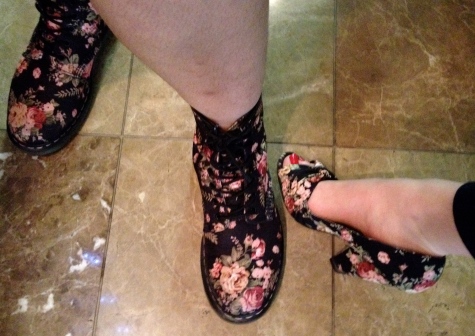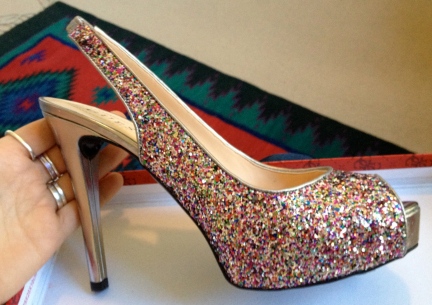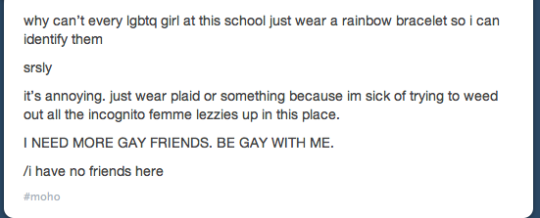Femmespiration and Femme Wins
This is the post full of femme awesomeness. Y’all may have noticed that this is a recurring theme, but here’s where it takes center stage. Why? Because I have spent way too much time in queer communities and spaces that were/are riddled with femmephobia–in which I was made to feel really insecure about my gender presentation, or felt compelled to dress down all the time to avoid attention, or was constantly told (implicitly and explicitly) that femme was pretty much worthless and if I truly wanted to fight the patriarchy I’d present myself in a masculine way. Ughhh so much BS. (Need further explanation? See: 87% of this blog.) As a way of retroactively counteracting some of this negativity, I’ve decided to make a list of femme-positive moments. Most are directly from my life; some I’ve observed.
Note: this is not a checklist of things required in order to ID as femme, nor is it a list of things that all femmes relate to, nor is it my entire conception of femme. It’s a scattered collection of fun moments that I associate with femme or that exemplify how I do femme. So, here goes…
- Seeing other femmes out and about and smiling at one another. Especially when we’re both reading queer theory on the train.
- Nail polish with huge chunks of glitter in it. I like to call this “don’t fuck with me” glitter.
- Heels: some haters pity me for my apparent lack of awareness that I’m wearing tools of the patriarchy on my feet. Fuck that~~if I’m in 3″ heels, I walk taller and you’ll be able to hear me coming from down the street. Heels are powerful.
- Enormous purses: why yes, I do carry a huge ass Mary Poppins bag at all times. Laugh all you want, but when you need water, band-aids, medicine, tissues, pens, gum, hand sanitizer, sunblock, gloves (the wool kind or the latex kind), lotion, a bottle opener, books, etc., you know I’ll have them.
- Realizing that that plum eye shadow really does compliment the gold eye shadow and accentuate your eyes perfectly.
- Fuchsia lip gloss: I maintain that this is the key to improving any day.
- Magical jacket: it’s sheer, translucent, green, blue, leopard-print, and chunky zippered all at once. I know this sounds like an impossible combination, but it’s actually the best thing ever.

(Oh yes, this is my face. It’s been a while~~hello.)
- As a femme cis woman: breaking stereotypes of what queer women are “supposed to look like.”
- Glitter. Did y’all here that? GLITTER. This is basically my life motto:
 (source)
(source)
- Rejecting the notion of “high maintenance.” I hear this thrown around all the time as a criticism of femme folks. Femininity is deemed superfluous and superficial; by extension, femmes are viewed as super demanding/unreasonable if we spend a lot of time/energy on our physical appearance. Fuck that. If I spend over an hour sitting in front of a mirror doing the most elaborate makeup for a party, I don’t need your approval. If I bring a bigger suitcase than you because I needed to pack bunches of scarves and shoes (while you brought a pair of jeans and two extra shirts), my choices and opinions aren’t magically less valid. I just intend to wear different fabulous outfits every day, while spewing my still informed, intelligent, valid opinions. You’ll look fierce in your jeans and tees; I’ll look fierce in a never-ending series of fabulous shoes.

(source)
- Re-imagining femininity on our own terms: defined by our own values and desires, not the kyriarchy. Resisting the pressure to be white (or at least light-skinned), slim and also hourglass-shaped, able in all ways at all times, passive/quiet/unopinionated, dressed in ways that require large budgets, etc. I love seeing and hearing about how other femme folks navigate these pressures and still look and feel fly.
- Huge flowers: in our hair, pinned on our clothes/bags/shoes, on jewelry, painted on our nails, painted on our faces, etc.
- Poofy skirts. They’re the best. Pencil skirts are the other best, as are huge bell-bottom jeans. Cozy sweatpants are the other other best.
- Sequins. ‘Nuff said.
- Coincidental fabulousness: that time when my shirt, lingerie, and phone case were all leopard-print, and I didn’t even notice til I was almost out the door.
- Not being forced into or ashamed of femininity–(re)learning that it can be awesome/fabulous/wonderful/powerful/sharp/full of pizazz.
- These shoes:
- The story behind that picture: taken on the last day of Femme Con 2012. I was talking to a new femme friend (and recent Seven Sisters grad~~woot woot!) when suddenly this dapper person races across the lobby to us with a camera, pointing excitedly at our feet. “Can I take a photo of your shoes??” We looked down. I was wearing the peep-toe wedges; she’s got the combat boots. They’re upholstered in exactly the same fabric. We had no idea. By this point, we’d been in a workshop together and had been standing next to one another for about ten minutes, never realizing that we were wearing matching shoes. *Commence OMG squeals*
- Later realization: that was the first time I’d experienced a masculine-of-center person making a beeline for femmes to compliment our style, rather than the other way around. Perhaps this seems insignificant or surprising to you, but for me, it was definitely a wow moment of “oh yeah, my gender presentation is valued and appreciated by people besides myself.”
- Shared experiences: connecting with other femmes and finding words for things you didn’t realize you were struggling with, so now you have a name for that thing that makes you so mad/frustrated/confused/joyful that you weren’t able to articulate before or were afraid no one else would understand.
- These shoes:
I own these shoes. Bonus: I just finished a show for which I wore them every Thurs-Sun for a month. Holla.
- Huge shout-out to all the femmes of color! Y’all are so gorgeous and your styles so fierce and your words so inspiring. I say this not because I think you need my validation, but because I know that in some queer spaces, femme is most readily visible on white bodies. In white-dominated queer spaces, we (white folks) often overlook QPOCs and marginalize your experiences. I’m sorry. I try my best to recognize when this happens/might happen and to do something proactive about it. Always a work in progress, but I’m striving to be your ally.
- Fascinators: Kate Middleton isn’t the only one rocking them; that’s all I’m saying.
- Femme flagging: y’all get so creative! I’m impressed. Femme folks are going all out with strategically pinned flowers, jewelry, handkerchiefs in hair and on shoes/belts/wrists, and oh my god the nail polish.
- Metal spikes and studs on clothing/shoes: rock on with your tough selves!
- Cupcakes: baking them, eating them, cupcakes as patterns on cloth, looking like a cupcake personified~~it’s all good.
- Shout-out to femmes of differing abilities and body shapes/sizes! Obviously our heteronormative society has a certain set of beauty standards. Beyond this, queer communities have developed standards of beauty/attractiveness that often perpetuate the same oppressive norms that we’re theoretically fighting. Fuck all that. This goes back to my point about defining femininity for ourselves, on our own terms. Seeing people do this–however they’re doing it–is inspiring and beautiful.
- Politicizing rhinestoned corsets
- Mixing colors/patterns and not being afraid of being over the top. As we learned from To Wong Foo, Thanks for Everything! Julie Newmar…

Larger than life is just the right size!








